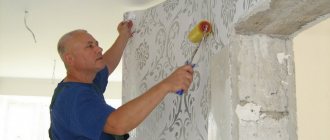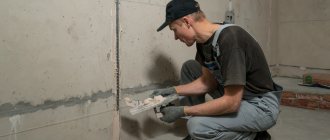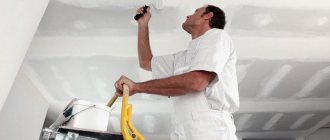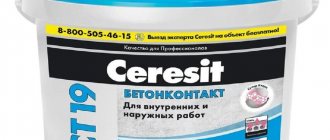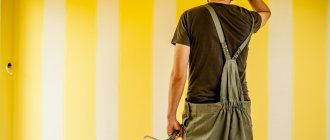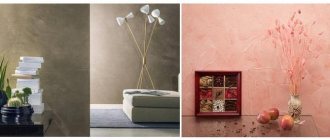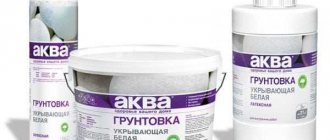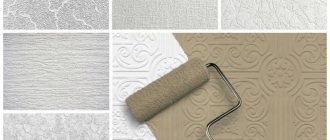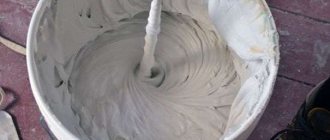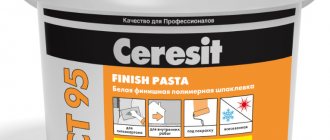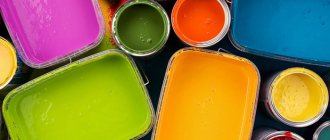Types of putties by composition
Various components can be used as the basis for the manufacture of putty. Therefore, such material may differ in composition and the following types are distinguished.
Cement
The cement putty contains sand, water and fine, with a small amount of impurities, cement grade M400 or M500. The mixtures are inexpensive, since all its components are available. Before use, the composition is diluted with water.
Advantages:
- durable, the cement layer can only be cracked with a hammer blow;
- can be used for rooms with high humidity;
- affordability;
- made for facade work, as it is resistant to sub-zero temperatures.
Flaws:
- difficulty in application, experience is required;
- weak elasticity, sanding must be done immediately after applying the composition to the walls.
- shrinkage, sometimes you have to putty the walls again;
- long drying;
- over time, cracks may appear on the cement base;
- not suitable for wood surfaces.
The cement composition is not suitable for finishing walls for painting due to its coarse-grained structure and grayish tint. But such material can be used to putty walls under tiles, for example, in the bathroom or kitchen.
Plaster
Plastic white gypsum-based putty is exactly suitable for painting walls. Thanks to its composition, the base is perfectly smooth. At the same time, its composition is environmentally friendly. A surface finished with such material absorbs water, but as the air dries, it releases the required amount of moisture to the room.
Advantages:
- the ability to obtain a perfectly smooth surface;
- does not shrink;
- quick drying;
- safety, air passes through the plaster, it is not subject to mold formation;
- fire resistance;
- additional thermal insulation of walls;
- affordable price.
Flaws:
- low resistance to sudden changes in temperature and moisture;
- can help accelerate metal corrosion;
- low strength.
Gypsum putty can also be used as a starting, finishing and universal putty.
Polymer
This finishing material is expensive, but of high quality. The basis of the putty is a polymer, but it can be different, so polymer mixtures may differ in composition.
And here the following types are distinguished:
- Acrylic. Ideal for leveling any base, the surface is smooth, even mirror-like, so the material is used not only for walls, but also for ceilings. Acrylic is easy to work with, it does not have an unpleasant odor, is not afraid of water, and does not tend to shrink, but it is expensive.
- Latex. The base is made of acrylate latex, thanks to which the surface is flawlessly smooth. The material is suitable for different surfaces, but only indoors.
- Polymer-cement. This putty is similar to cement putty, only it is more elastic due to the introduction of polymer components into its composition. Suitable for brick and concrete surfaces.
There are also other types of putty material, for example, oil putty, oil-adhesive putty, putty. But they are used very rarely, mainly for finishing window sills, window openings, baseboards, etc.
Putties for interior work
Among the huge variety of finishing materials offered by manufacturing companies, both technical and decorative, putties are among the leaders. They are classified according to one of the main differences - how ready the mixture is for use. There are putties that are completely ready for use, offered in plastic containers, and dry ones, packaged in bags.
Ready putty
Before you figure out what putty to use for wallpaper, it’s worth learning about the benefits of the finished material.
Pros:
- Its differences are uniformity and excellent plasticity.
- It is very easy to apply to the wall.
- It has the ability to be stored for a long time without loss of properties provided that the container is tightly closed.
- Usually used as a finishing touch. It can also serve as a base for painting and can be tinted well.
Minuses:
- High price.
- Restrictions on storage conditions - cannot be frozen.
- The shades of decorative putty may differ in different batches.
Dry putty
Pros:
- Has an affordable price.
- Can be stored for a long time if the packaging is intact and is frost-resistant.
- Possibility of adjusting the size and thickness of the batch.
- Mixtures are divided into two categories: starting putty, used for leveling walls, and finishing putty, used for wallpapering or other types of decorative finishing.
- There are universal-purpose putties that are suitable for both initial wall treatment and finishing work, for example, Knauf multi-finish.
Minuses:
- It takes time to mix the working solution.
- To prepare the mixture, you need skill in determining the correct ratio of the mixture and water, as well as special devices - a drill with an attachment or a mixer.
- The mixture dries quickly and cannot be reused. You need to decide in advance on the volume and quickly complete the work.
- The desired shade of decorative finishing putty may differ in different batches.
Dry plaster mixtures differ in the materials used as the base:
- Gypsum – have a white color and are characterized by high plasticity. Gypsum mixtures are easy to apply and sand, and dry quickly. It is not advisable to use such putty in rooms with high humidity.
- Cement - mainly used for external work, as well as for finishing premises with high humidity. Frost-resistant, with low moisture absorption. The best base for this type of putty is brick or concrete.
- Polymer - usually used for processing joints, seams, cracks, as well as for finishing walls for painting. Plastic, have excellent viscosity. Recommended for use in decorative finishing in new homes if there is a risk of shrinkage and deformation of the walls.
- Glue-based putty - consists of drying oil, glue and chalk. It fits well on walls with small defects, leveling and filling existing cracks. It is applied in a thin layer, which after drying has great strength.
- Oil-adhesive - acrylates and polymer plasticizers were added to the components. It is used only indoors on surfaces that have low adhesion and require leveling: wooden, dense concrete, as well as on walls prepared for painting or pasting with light wallpaper.
- Latex – the area of application is the same as that of an oil-adhesive mixture. It contains water, polymer additives and fine calcite sand. Forms a thin, even layer of great strength.
Acrylic putty is a universal mixture that is used for external and internal work. Acrylic in the mixture promotes excellent application on any surface, which as a result becomes even and smooth.
There is no need to prepare the working mixture, since it is sold ready-made and can be stored in a plastic container for a long time without retaining its properties. It has a paste-like consistency, making it easy to apply and spread over the wall. Acrylic putty has water-repellent properties and is elastic; after drying, it does not crack, does not shrink, and perfectly levels the surface of the walls.
Plaster and putty
Plaster and putty are used to level walls in rooms. Serious unevenness is corrected with plaster, and minor defects are corrected with putty. The plaster contains rather large granules, which do not allow it to be used to fill small holes and cracks in the wall. This is where putty comes to the rescue and easily removes them.
During the repair process, both of these mixtures are indispensable. Performing each of its functions, they make the walls perfectly even and smooth.
What type of putty is the cheapest?
Any builder can easily answer this question. This putty is made on an oil-adhesive basis. The composition includes drying oil, which makes the composition cheap. This putty for walls and ceilings is considered obsolete for one reason - it can only be used under coating with drying oil-based paint. Otherwise, your wallpaper or paint will end up with chaotic oil stains.
This composition is deeply absorbed into the wall, so during the next repair you cannot do without degreasing. Plus, experts call drying oil not the most useful material for use in residential premises. Assumptions about its harmfulness have been confirmed more than once by the fact that some people showed signs of allergies when living in a room with this type of finish. Another disadvantage of this type of putty is its fragility. It cannot guarantee a long service life.
Oil-adhesive putty will cope well with the treatment of wooden walls
But oil-adhesive putty also has positive qualities. First of all, this is an increase in waterproofing of the treated surface. And when working with wooden walls, it is an indispensable assistant. By treating a wooden ceiling or wall, you can be sure that the wood will be protected from rotting and moisture.
Benzene composition
How to make your own benzene-based putty? It is enough to get a few components. Take about 25 grams of castor oil. Combine the substance with benzene in an amount of 150 grams and mix the composition. Then add 50 grams of rosin heated over fire. The result is a putty that will provide a high-quality finish to wooden surfaces and concrete walls.
How to prepare putty for use: step-by-step instructions
Almost all types of putty are sold in stores in the form of a dry mixture - the exception is acrylic, which is completely ready for use, and to start using it, you just need to mix it. In this regard, dry mixtures are slightly inferior to them - they require proper preparation. How to prepare dry putty mixture for application? This is done quite simply.
- Pour water into a clean bucket in the amount of 1/3 of the existing capacity. We pour cold water, since hot water speeds up the hardening process of the putty.
- Pour the dry mixture into the water. It’s difficult to talk about the required quantity - it all depends on the desired thickness of the finished putty. For example, to apply the final layer, it is better to prepare a thinner solution than to putty the walls with the first layer. In general, based on practice, enough dry mixture is poured in to form a slide 100 mm high above the water. If it is not enough, then at the first stage it can be added.
- We take a construction mixer and perform initial mixing, the purpose of which is to soak the dry mixture with water.
- Leave the composition alone for about five minutes, during which time the gypsum powder should thoroughly soak. If this is not done, lumps will form in the putty.
- After five minutes, use the same mixer to mix the composition until a homogeneous mass is obtained and again leave for a couple of minutes alone. Then we repeat the mixing procedure.
In a good way, the putty takes a long time to prepare - it is mixed in several batches. A person with experience sees its condition and knows when to start working. And without experience, you will have to rely on hours or advice from specialists who say that you need to mix in at least three passes, each of which lasts 3-5 minutes.
In conclusion, considering the issue of types of putty, I want to give a couple of small tips on its use, or rather there is only one advice, but two consequences follow from it. Firstly, you should not prepare putty in large quantities, since it thickens over time and it becomes almost impossible to putty with it. Secondly, you should not re-dilute thickened putty, especially when it comes to applying the finishing layer - it comes in lumps and begins to thicken twice as fast. Just throw the thickened mixture into the trash, thoroughly clean and wash the bucket and mix a new portion of the solution, but in smaller quantities.
Author of the article Alexander Kulikov
Tools and application rules
Mixtures for plastering surfaces are sold in different forms. This may be a dry mixture. An aqueous solution of the mixture must be developed so that it does not lose its qualities. It is much more convenient to purchase ready-to-use putty, which retains its properties for a long time. Textured decorative plaster is especially convenient for self-application. Experts say that in order to ruin such a coating, you have to try very hard. In addition, there is no need to prepare the walls too thoroughly. When puttying, the textured mixture itself perfectly smooths out defects.
Before applying the coating, the wall is cleaned of old decor and the cracks are sealed. This preparation is sufficient for bark beetle plaster. And, for example, Venetian coating requires much more thorough preparation, for example, leveling the walls to perfect condition.
The required minimum tools for puttying are as follows:
- Set of spatulas.
- Metal ironing board.
- Grater made of plastic or wood.
- Plaster roller.
- Container for water and ready-made solution.
Quality Standards
To understand what to expect from putty mixtures, you first need to find out what requirements are put forward for them from a professional point of view.
High-quality finishing putty is characterized by the following features:
- when mixing dry mixtures, there should be no lumps in the solution;
- high adhesion – strong connection with the surface material at the molecular level;
- finally levels the surface to a flat plane;
- easy to apply;
- the solution does not slide down the wall;
- after the solution hardens, cracks do not form;
- easy to sand;
- painted a uniform white color over the entire application area.
Manufacturers
Currently, one can note a relatively large selection of gypsum putty, but not all of it is popular and of high quality. Unfortunately, all materials produced in Russia and the CIS are of very questionable quality at an unreasonably high price.
Some of the best putties are considered to be products from the Knauf company, produced in various modifications. Often, when you search for “gypsum putty,” a photo of this company’s product appears. But there is no classic starter in their assortment, but there are finished products (after opening the bucket you can start putting putty) for each of the products in the range.
Ceresit putties, produced as starter and facade putties, have proven themselves to be quite good. Pairs perfectly with Knauf products. Also, some types of putty are produced by the well-known company Tikkurila, but it is known for its paints. But the putty of this company is also of high quality.
The Polish company Alpol, specializing in bulk materials, presents starting (S20) and finishing (S22) putty. Almost all builders who can buy this company give preference to it. But since Alpol does not produce a universal one, another Polish manufacturer Acryl Putz gained its popularity precisely in the segment of universal gypsum putty and rightfully occupies its niche.
Advantages and disadvantages
Like every type of putty mixture, latex-based mortar has its own advantages and disadvantages.
The advantages of this composition include the following properties and characteristics:
- The coating has minimal shrinkage.
- Some types of latex coating are resistant to temperature changes. This property allows the material to be used not only for interior, but also for exterior wall decoration.
- Resistance to precipitation.
- Wide range of different shades.
- High adhesion rates with various materials.
- Due to its viscous consistency, the solution easily penetrates and fills cracks on the surface.
- When dry, it forms a highly durable coating.
- Good elasticity.
- Excellent as a base for painting. This coating does not absorb paint solutions, which reduces paint consumption during finishing.
- Ease of construction work.
- The resulting coating does not crack or crumble.
Despite the impressive advantages of latex putty, it also has its disadvantages.
Let's consider the main disadvantages of the material:
- The prepared solution should not be exposed to low temperatures. When frozen, the material loses some properties. Therefore, even if the solution is thawed, it will no longer be suitable for use.
- The price for such a coating exceeds the cost of many types of putty. However, this material can be applied in a layer one millimeter thick, unlike acrylic or cement putty, which can significantly reduce the consumption of the mixture.
Technique for applying leveling solutions
To apply the finished solution, use a spatula. Spatulas come in plastic, metal and rubber. Also, the working surface of the tool can be narrow or wide. Watch all about the technology for proper wall alignment in this video:
Use a narrow spatula to distribute the mixture over a wide spatula.
The thickness of the leveling layer depends on the angle of inclination of the working plane of the spatula. If you do not have experience with the tool, then you should first practice on small areas of the surface being processed.
When performing work, use two spatulas. Using a narrow spatula, scoop up the finished mixture and apply it to the working tool, distributing it evenly across the width of the spatula.
The greater the angle of inclination of the spatula in relation to the working surface, the thinner the layer of putty will be. Accordingly, a low blade angle will create a thicker coating.
Types of mixtures by composition
When choosing wall putty, you need to study the components of various products.
It is impossible to say for sure which mixture is the best. Let's consider the composition and characteristic properties of building materials:
- Made from plaster. It has a low cost, which, in turn, makes the mixture attractive to the buyer. The main disadvantage of putty is the lack of water resistance. It can only be used for objects not exposed to moisture;
- Made from cement. These are waterproof solutions that shrink greatly during the drying process, which is why they have a limited scope of application;
- Polymer. The products do not show any significant shortcomings; working with them is easy and convenient.
To understand which putty for walls is better, we will dwell in detail on the basic materials and properties of various solutions.
Cement base
The components of putty are sand, cement and water. To make the mixture, building materials M400 and M500 with a high strength grade are used, fine sand is taken - river sand. The product is sold in the form of dry mixtures. In order to prepare the composition yourself, you need to combine 1 part cement with 3-4 parts sand. Having made the dry mixture, it is mixed with water. The material should not be too thick or too liquid. In the absence of appropriate experience, it is difficult to make the right solution. For this reason, it is better to trust the professionals and buy a factory mixture that does not require dilution.
Gypsum base
The white mass is often used to prepare walls for painting. Gypsum putty allows you to get a flat and smooth surface. A distinctive property of gypsum is that it takes excess moisture from the air, and then gives it back when the air becomes too dry.
Polymer base
The product is made on the basis of polymers. This is a good putty for walls.
Depending on which main component was used, the following compositions are distinguished:
acrylic putty is a modern polymer finishing material based on liquid acrylic. It is considered a universal remedy that is successfully used to eliminate defects on brick and concrete, wooden floors, metal structures, plasterboard sheets, as well as for finishing work. The mixture allows you to obtain an absolutely flat surface, which makes it possible to use it for walls and ceilings. The material can be applied in a thin layer or create a dense coating. The product is purchased both for indoor and outdoor work. It has proven itself well when used in “wet” conditions. This putty is characterized by good adhesion to the surface. The mixture does not emit unpleasant odors and creates a durable layer. Another advantage is that the putty does not shrink. When purchasing a product, be careful: you should beware of low-quality goods, which may contain foreign impurities. This product will scratch the surface!
- latex putty - the solution includes acrylate latex (styrene), plasticizers and modifiers, as well as biocides and tint additives. Often purchased for use as a finishing layer. The mixture allows you to obtain a mirror-smooth surface. It is not recommended to create a layer that is too thick, otherwise the composition may crack. The scope of use involves carrying out internal work. The putty can be applied to wood, brick, plasterboard or concrete.
- polymer cement putty. Such solutions contain cement, mineral additives and lime. The presence of polymer components makes the mass very plastic. The product is used to change the geometry of the walls of concrete and brick structures. In this case, the application layer should not exceed 20 mm.
Oil-adhesive putty
The material of the presented type will serve as a good basis for rubbing surfaces that are planned to be treated with oil paint. How to prepare a putty solution of the appropriate nature? Obtain the following components:
- Putty varnish – 1 liter.
- Chalk - about 2-3 kg.
- Liquid wood glue – 100 g.
So, how to prepare putty? Combine wood glue and putty varnish in a bucket. Stir the ingredients until smooth. Slowly add enough chalk to ensure that the putty is not too thick.
Types of materials and properties
Wall putties are divided according to the base material: gypsum, cement, etc. Depending on this, it is already clear for what purposes they can be used.
There are putties:
- Cement. There are for external and internal work. Scope of application: concrete and brick walls. Cement putties are moisture resistant. They can be used to cover surfaces in rooms with high humidity, bathrooms, for example. This material withstands temperature changes.
- Polymer. They are used for sealing wall defects, as well as finishing work.
- Finishers. The name speaks for itself: they are intended for finishing surface treatment, that is, for eliminating minor wall defects after treatment with starting putties. A layer of up to 1 mm is applied. As a rule, there are several layers; they are applied in stages after the previous one has dried.
- Universal. They are highly durable. The putty is sold dry. After application, the surface becomes gray or white. Easy to sand.
- Water resistant. The materials are used for both indoor and outdoor use. They are suitable for various substrates: concrete, cement, plastered. They are highly resistant to moisture.
- Oily. Contains additives in the form of driers and chalk. They are intended for covering window and door slopes in rooms with high humidity. Serve as a basis for water-based and oil-based paints.
- Adhesive. Contains drying oil, chalk and glue. Their structure is strong and they apply perfectly.
- Oil-adhesive. Contain additional inclusions: plasticizers, drying oil, acrylates. They successfully putty concrete and wooden surfaces. Can be applied to a plastered wall for painting or wallpaper. For interior work only.
- Latex. Contains additives: calcium, plasticizers and acrylates. They are intended for interior work only.
- Acrylic universal. Made from various chemical components. After applying them to the wall, a fine-grained surface is obtained. It sands well and does not crack after drying. It is considered a safe material for the health of the worker and the user too. Used for interior finishing of any surfaces. The thickness of the layer is not limited.
- Facade acrylic. It has increased moisture resistance and can be used to process concrete, wood, and plaster. Does not crack, excellent strength. Can be sanded.
- Shakril. This can be used for tiling ceramic tiles in dry rooms, as well as for plastered surfaces. It is also used as whitewash, diluted with water.
No. 7. Large putty manufacturers
The putty market today is oversaturated - you can find a mixture of any composition, for any type of surface and, most interestingly, at almost any price. We all love to save money, especially when it seems that there is no difference at all between two similar products. When it comes to putties, saving money doesn’t seem like such a reasonable thing, because it’s unlikely that anyone would want the putty layer to crack and fall off along with the paint after a few months. It is better to trust the products of large manufacturers:
- Knauf is a large German company, whose factories are today located all over the world, incl. in Russia, which allows us to buy quality products at more affordable prices. Knauf putties are presented in cement, gypsum and polymer compositions, sold in dry and ready-made form. There are solutions for all areas of use. The company’s special solution is gypsum putty with components that protect against X-ray radiation;
- Ceresit is a product of a large concern that is very popular all over the world. Cement and polymer putties are sold under the Ceresit brand;
- Tikkurila is another well-known concern that, among other things, produces putties. The company offers acrylic moisture-resistant and gypsum compositions. The range also includes Euro Filler Light putty, which is easy to apply and eliminates the need for sanding - the surface itself becomes smooth. The color of the composition can be chosen from 15 proposed. The company also offers Spakkeli wood putty, which is suitable for treating doors, furniture and other wooden surfaces indoors;
- Vetonit offers polymer, cement compositions and putties with an organic binder. There is a composition that will not only smooth out seams on drywall, old painted surfaces and wallpaper, but will also create a textured decorative surface;
- Kreisel is a German company that has factories in 20 countries, incl. in Russia. Putties are represented by cement and gypsum compositions;
- “Prospectors” are domestically produced putties. The quality is good, prices are affordable. The range is represented by gypsum, cement, polymer-cement and polymer compositions, which are suitable for starting and finishing work in dry and wet rooms, as well as for outdoor work;
- Volma is another domestic manufacturer that has proven itself well. The range of compositions is very wide. There are gypsum and polymer putties with different particle sizes. There are solutions for any situation.
You can also recommend the products of Ural Construction Mixes, ARMstrong and Eurogypsum.
When purchasing, do not forget to inspect the integrity of the packaging, pay attention to the expiration date and, if desired, ask for certificates of conformity - any responsible manufacturer and seller should have them. The article was written for the site remstroiblog.ru
The article was written for the site remstroiblog.ru.
